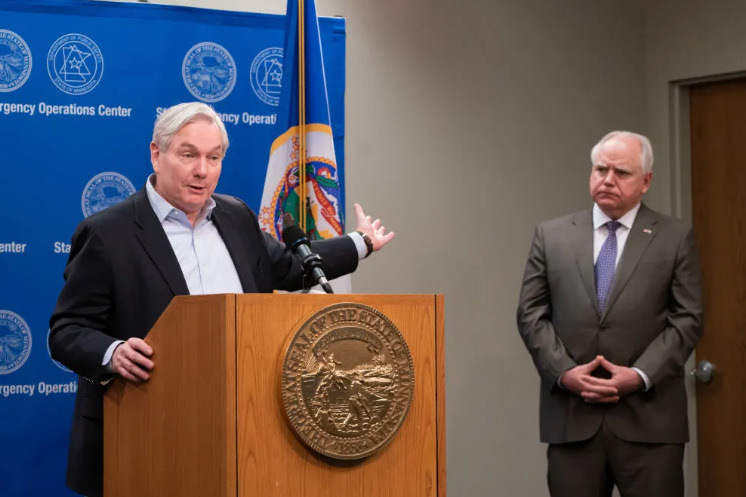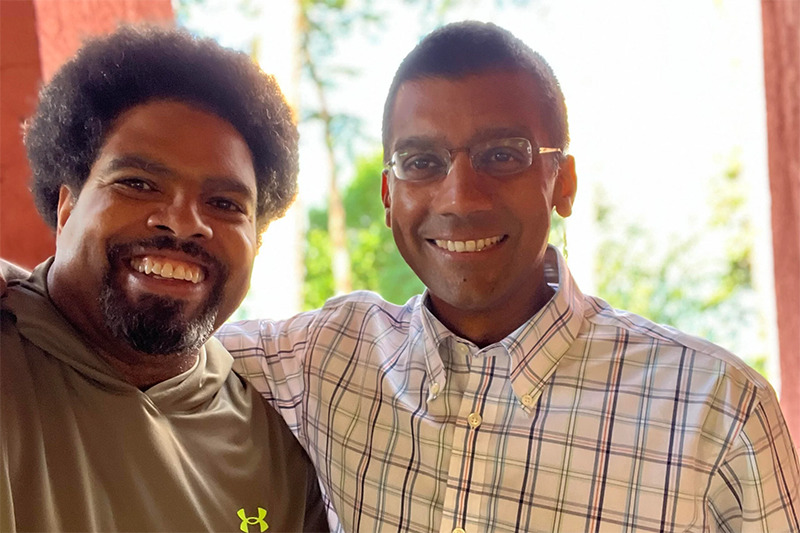
Time to end secret data laboratories—starting with the CDC
The American people are waking up to the fact that too many public health leaders have not always been straight with them. Despite housing treasure…
Thought Leader: Marty Makary

When Covid hit the US and many public health experts were trying to act strong and confident, epidemiologist Michael Osterholm took a different approach. Asked about the novel coronavirus, he often replied honestly, “I don’t know.”
But Osterholm, now 71, knew at least as much as anyone else about infectious disease. He had spent his career investigating outbreaks, including bird flu in Vietnam, Ebola in Africa, HIV in the United States, SARS in Asia and MERS as an advisor for the royal family in the United Arab Emirates. When Covid broke out, he was director of the Center for Infectious Disease Research and Policy in Minnesota, a position he still holds.
Osterholm’s approach to the pandemic — admitting uncertainty, declining to offer false hope, carefully explaining why he believes what he does, avoiding the political fray and staying nonjudgmental when guiding the misinformed — could be a template for how to restore trust in public health and science to a country that desperately needs it.
I reached out to him to learn more about his personal philosophy of communication, and to see if his experience guiding his audience through the worst of Covid-19 could help create a roadmap other scientists might follow in the future.
As the virus spread from China to Europe to the US, the public was desperate for answers. But Osterholm says he tried to provide context while also explaining the limits of his knowledge — which he did in editorials for the Washington Post and interviews with mainstream media sources — including me. “What I knew was just a thimble of information compared to a Lake Superior’s worth of questions,” he told me of those early days of 2020.
Despite those unknowns, part of his commitment to transparency meant he didn’t shy away from sharing his fears — in contrast with the reassuring approach many other experts were taking at the time. In January and February of 2020, Osterholm was concerned that the new virus might explode into a dangerous global pandemic. He submitted warnings to the major medical journals, which turned them down and continued to run pieces with the message that influenza remained the bigger danger.
By March, Michael Osterholm was predicting that the disease might kill hundreds of thousands of Americans within 18 months. He was right. About 700,000 had died by October of 2021, with the total US death toll now reaching more than 1 million.
Despite these fears, his tone remained consistently kind and nuanced at a time when snark and bluster were driving engagement online and in the media. “He’s very thoughtful, in every sense … a deep expert,” said Brown University’s dean of public health, Ashish Jha, who was the White House COVID-19 response coordinator under President Joe Biden. Jha said he sometimes called Michael Osterholm to tap into that expertise as he wrestled with questions of pandemic policy.
Osterholm’s treat-the-public-like-adults approach is perhaps why, in early 2020, he was asked to be a guest on the Joe Rogan Experience, one of the most popular podcasts in the world. “I’d never done a podcast,” he said, “and I’d never heard of Joe Rogan.” But he trusted his staff, and they told him he should do it, so he flew to Los Angeles and did the interview on March 10, 2020.
“He asked a lot of good questions,” Osterholm says of Rogan. That includes questions that put the epidemiologist in the uncomfortable position of bucking the scientific party line. When Rogan asked why the experts seemed divided between those predicting an apocalypse and those insisting the virus was less threatening than the flu, Osterholm says he answered honestly: Some in the public health community were trying not to panic people.
That’s far from his own approach, which he’s described as trying, “not to scare people out of their wits — but to scare people into their wits.” He did so on Rogan’s show, as he often does, by turning to the data: Reports from China, where the virus first emerged, suggested Covid was much more of a danger to people over 75, as well as those with certain health problems, such as obesity, he explained.
He also cited early data pointing to a number of factors that hadn’t yet been publicly recognized by parts of the scientific community, but would soon prove accurate: that the disease was spread primarily through the air, that it would likely circulate for months if not years, and that loose surgical masks and hand sanitizer could not offer reliable protection.
When he got home, Osterholm saw that the episode had 10.5 million downloads — and a long string of appreciative comments. “I thought, wow, this is how you reach people.” Within a month he had launched his own podcast, The Osterholm Update.
The format was a good fit for a scientist who had a lot to share with the public, but never took to social media. (“That’s just not my style,” he says of Twitter, where overconfidence and outrage generate virality.) His team told me the show has been downloaded 6.5 million times and counting, with the most popular episode nearing 90,000 listeners. It still comes out every other week.
Osterholm wasn’t entirely sure how to approach the podcast at first, but seemed to find his voice when he dedicated an early episode to a friend who had died. “I said some very personal things that were not planned,” he says. He’s continued to use the outlet to share his human side.
He told listeners he’d grown up in rural Iowa, one of six siblings with an abusive, alcoholic father. He said he became fascinated with medicine when a local newspaper editor gave him copies of the New Yorker, where he became enthralled by the medical detective stories by legendary staff writer Berton Roueche. It was the following of clues — the curiosity-driven investigation, he says, that hooked him.
Being a good detective — or a good scientist — means recognizing uncertainty and being willing to change your mind when new information surfaces. Brown’s Jha points out that during the early days of the pandemic, politicians and their scientific advisors didn’t have the ability to wait for all the facts; they had to make major policy decisions amid uncertainty and scientific disagreement.
At the same time, they were facing an unpredictable stream of misinformation, and a president who often undermined their efforts — stating publicly with confidence that the virus would “go away” “like a miracle,” or that the drug hydroxychloroquine would be “one of the biggest game changers in the history of medicine”
But to Osterholm, facing such challenges calls for nuance. That means not overstating certainty or flattening complicated scientific reality into blunt slogans like “vaccines work,” which, over time, erode public trust. He identifies the explosion of cases in mid-2021, when even vaccinated people were getting sick with the Delta variant, as a proof point. Officials hadn’t done enough to share the unknowns, he says: “It looked like we lied.”
“In public health,” he says, “We tell people what they’re supposed to hear, but we don’t tell them how we got there.”
When he took oppositional stances — as he did when he came out against lockdowns and early masking policy that recommended cloth and surgical masks — he did his best to explain what data he was relying on and why he believed a certain policy would or would not accomplish the goal.
He took listeners inside his own decisions, explaining why he continued to wear an N95 in public long after mandates were removed (he considered himself at elevated risk because of his age) and why he made safety trade-offs, like having small, unmasked dinner parties with friends in 2023, using rapid tests as a precaution.
His role, as he sees it, isn’t to evangelize — it’s to provide a space where anyone can ask questions and get a trustworthy answer. The podcast has also been a place where people could find a sympathetic ear if they were feeling fearful or isolated.
His reward has been the sense, he says, that he’s paying forward kindness others have shown him. He’s also been gratified by the positive — or at least constructive — feedback he’s received. “I can’t tell you how many emails I’ve gotten from people who touched my life immensely,” he says.
Of course, it hasn’t always been easy. Trying to communicate in the midst of an unfolding crisis, with science that’s still in flux, can be frustrating for everyone involved. “We don’t have the answers people want to us to have,” he says.
There’s also the reality that no matter how plainly you speak, some listeners won’t be open to what you have to say. In 2021, Osterholm was invited to do a second interview with Joe Rogan, who by then had been widely criticized for allowing fringe scientists to spread misinformation on his show.
Some might have turned it down, but Osterholm says he believed he could better serve Rogan’s massive audience by going on and offering them facts, even if many would discount them. The conversation lasted almost two and a half hours, and he believes it allowed him to get his message out.
The epidemiologist says he occasionally received hate mail and threats, including some aimed at his family — in one case from someone claiming to know where his daughter and grandchildren lived. Pleasing even devoted fans can be hard: When he told listeners he’d finally stopped routinely wearing an N95 mask, some felt abandoned and betrayed.
“This wasn’t arbitrary,” he told me. The data showed cases were way down, and he’d thought through his personal balance of risk against the benefit of living normally. He’ll mask up again if the situation calls for it, he says.
These days, his listeners are particularly interested in the H5N1 flu virus that’s infected cows and several dairy workers. In his most recent interviews, he raised the chilling possibility that the udders of infected cows could be the breeding site of a new pandemic virus. All it would take, he says, would be for a dairy worker carrying human flu to pass the virus to a cow that also carried H5N1. But at the moment at least, he disagrees with colleagues who say an H5N1 pandemic could be imminent.
“It’s really important to understand that no one — and I mean no one — knows what H5N1 influenza virus is going to do to the human population,” he said on an episode titled Uncharted Territory. “If we continue to say we’re on the edge of a pandemic and in a year or two we don’t see that happen, we will see another loss of credibility in public health.”
Vigilance and caution are good. But presenting guesses as fact ignores the hard-won lessons of the past four years. The reality is, once again, we just don’t know.
Time to end secret data laboratories—starting with the CDC
The American people are waking up to the fact that too many public health leaders have not always been straight with them. Despite housing treasure…
Thought Leader: Marty Makary
Sanjay Gupta: Can Safety and Excitement Coexist in the NFL
This is the episode of Chasing Life with Dr. Sanjay Gupta. ‘One of the most dangerous plays in football, the kickoff, is getting a makeover…
Thought Leader: Sanjay Gupta
A Meeting of the Minds at Bellagio Spurs a Convening and a Movement
A Bellagio residency leads to a Bellagio convening and a project to alter the U.S. economic system in favor of better health Two Bellagio Center…
Thought Leader: Dave Chokshi

